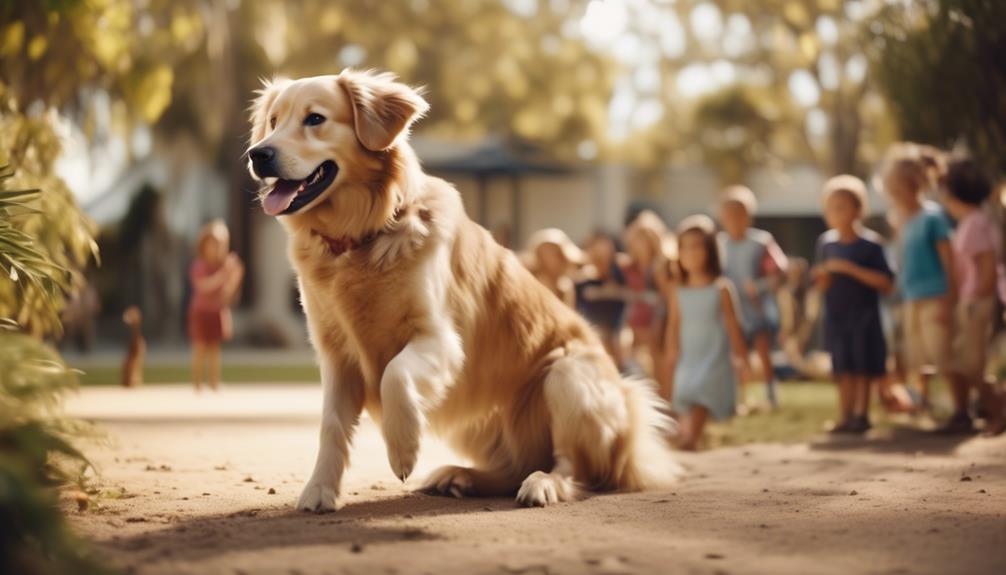Are you curious about the truth behind the theory that the Australian Retriever is a versatile and charming dog breed?
Well, get ready to uncover all the fascinating facts about this crossbreed that will surely captivate your interest.
From their origins and striking appearance to their adaptability and behavioral traits, there’s so much to discover about the Australian Retriever.
So, let’s dive in and explore the wonderful qualities that make this breed truly unique and lovable.
Key Takeaways
- The Australian Retriever is a crossbreed between the Australian Shepherd and Golden Retriever, known for their striking appearance and dense, water-resistant coat.
- They have a friendly and sociable temperament, making them great companions for individuals and families.
- Australian Retrievers may be prone to certain health issues such as hip dysplasia, cataracts, and epilepsy, so regular veterinary check-ups and responsible breeding are important.
- They require regular exercise and mental stimulation, with about an hour of exercise needed daily, and they thrive in safe off-leash conditions. Regular grooming is also necessary to maintain their coat.
Origin and Size
The Australian Retriever, a versatile and charming breed, originated in the United States as a crossbreed between the Australian Shepherd and Golden Retriever.
This medium to large-sized dog stands 20-23 inches tall for males, with females slightly smaller. The Australian Retriever has a striking appearance, with a dense and water-resistant double coat that comes in various colors such as black, red, blue merle, or a combination.
Their friendly and sociable temperament, combined with high intelligence and loyalty, makes them a great companion. They’re also known for their herding instincts.
However, it’s important to note that Australian Retrievers are prone to health issues like hip dysplasia, cataracts, and epilepsy, so regular veterinary check-ups and responsible breeding are essential.
With an average lifespan of 10 to 13 years, they make a wonderful addition to any family.
Striking Appearance and Temperament

With their striking appearance and charming temperament, Australian Retrievers are a breed that captures attention wherever they go. Their unique features and personality make them stand out in a crowd. Here are a few reasons why Australian Retrievers are so appealing:
- Beautiful Coat: Australian Retrievers have a dense and water-resistant double coat that comes in various striking colors such as black, red, blue merle, or a combination. Their wavy and coarse fur adds to their overall appeal.
- Friendly and Sociable: These dogs have a friendly and sociable nature, making them great companions for families and individuals alike. They’re known for their loyalty and intelligence, always eager to please their owners.
- Herding Instinct: Australian Retrievers inherit their herding instincts from their Australian Shepherd lineage. This makes them excellent working dogs and allows them to excel in activities such as obedience training and agility.
With their striking appearance and charming temperament, Australian Retrievers aren’t only visually appealing but also make wonderful companions for anyone seeking a loyal and intelligent canine partner.
Health and Lifespan

To ensure the well-being of your Australian Retriever, it’s important to understand their health and lifespan.
Australian Retrievers are generally considered a healthy breed, but they can be prone to certain conditions inherited from their parent breeds, Australian Shepherd and Golden Retriever. Regular wellness visits with the vet are recommended to monitor their health.
Common health problems that Australian Retrievers may face include hip dysplasia, cataracts, and bloat. It’s crucial to provide them with a diet formulated for large dogs with high energy to prevent weight gain and related health issues.
With proper care and regular exercise, Australian Retrievers have an average lifespan of 10 to 13 years, allowing you to enjoy their companionship for many years to come.
Adapting to Apartment Living

When living in an apartment, it’s important to consider how Australian Retrievers adapt to their new environment. These versatile and charming dogs can indeed adapt well to apartment living, but there are a few factors to keep in mind:
- Energy levels: Australian Retrievers are known for their high energy levels. Regular exercise and mental stimulation are necessary to keep them happy and prevent destructive behavior.
- Barking tendencies: Some Australian Retrievers may have a tendency to bark, especially if they’re bored or anxious. Training and socialization can help minimize excessive barking.
- Behavior towards neighbors: Australian Retrievers are generally friendly and sociable, but it’s essential to teach them appropriate behavior around neighbors to maintain a harmonious living environment.
Factors to Consider for Apartment Dogs

Consider important factors when choosing a dog for apartment living. While size is a common consideration, there are other crucial factors to keep in mind.
Energy levels play a significant role in apartment suitability. High-energy dogs may struggle in a limited space, while low-energy dogs are more adaptable.
Indoor playtime is another factor to consider. Some dogs require more mental and physical stimulation than others, so make sure you can meet their exercise needs.
Polite behavior towards neighbors is essential in maintaining a peaceful living environment. Some small dogs may have high energy levels and frequent barking, making them less suitable for apartments.
Lastly, consider your own lifestyle and experience as a dog owner. Some breeds are more suitable for novice owners, while others require more experienced handlers.
Suitability for Novice Owners

Novice owners will find the Australian Retriever to be a suitable and rewarding choice. Here are three reasons why:
- Easy to Train: Australian Retrievers are highly intelligent and eager to please, making them easy to train. They respond well to positive reinforcement techniques and enjoy learning new commands and tricks.
- Gentle Temperament: These dogs have a friendly and sociable nature, making them great companions for novice owners. They’re known for their loyalty and love to be a part of the family. Australian Retrievers are also good with children and other pets, making them a versatile choice for any household.
- Adaptability: Australian Retrievers adapt well to different living environments, including apartments. They’ve moderate energy levels and can be happy with regular exercise and mental stimulation. Their adaptability makes them suitable for novice owners who may be navigating the challenges of dog ownership for the first time.
Sensitivity Level and Tolerance to Being Alone

Australian Retrievers exhibit varying levels of sensitivity and tolerance when it comes to being alone. Some dogs are more independent and can handle being left alone for longer periods, while others may experience separation anxiety and become distressed when left by themselves. It is important to consider your dog’s individual needs and temperament when determining how long they can tolerate being alone. Here is a table to help you understand the sensitivity level and tolerance to being alone of Australian Retrievers:
| Sensitivity Level | Tolerance to Being Alone |
|---|---|
| Low | Can handle being alone for longer periods without experiencing anxiety. |
| Medium | May feel some level of discomfort or anxiety when left alone, but can manage for moderate periods. |
| High | Highly sensitive and may experience significant distress when left alone for even short periods of time. |
Understanding your Australian Retriever’s sensitivity level and tolerance to being alone will help you provide the appropriate care and support to ensure their well-being.
Tolerance to Cold and Hot Weather

When it comes to the Australian Retriever’s ability to withstand different weather conditions, their tolerance to cold and hot weather is an important aspect to consider. This breed is known for its versatility and adaptability, but their comfort in extreme temperatures is worth noting.
Here are some key points to consider:
- Cold Weather Tolerance: Australian Retrievers have a dense and water-resistant double coat that helps protect them from the cold. However, they aren’t well-suited for prolonged exposure to freezing temperatures, especially if they have short coats or little body fat. It’s important to provide them with shelter or appropriate clothing.
- Hot Weather Tolerance: Dogs with thick, double coats or short noses, like the Australian Retriever, are more susceptible to overheating. They should be kept indoors or in a cool, shaded area on warm or humid days. It’s essential to monitor them closely and ensure they have access to fresh water.
- Climate Adaptation: Australian Retrievers can adapt to a wide range of climates, but extreme temperatures should be managed carefully. Whether it’s providing them with extra warmth in the cold or keeping them cool in the heat, their well-being should always be a priority.
Remember to consider your Australian Retriever’s specific needs and adjust their environment accordingly to keep them safe and comfortable in different weather conditions.
Behavioral Traits and Aggression

Understanding the behavioral traits and aggression tendencies of the Australian Retriever is crucial for responsible ownership and ensuring a harmonious relationship with this versatile breed. While Australian Retrievers are known for their friendly and sociable nature, it’s important to be aware of potential aggression issues. Aggression in dogs can stem from fear and anxiety, and some Australian Retrievers may display aggression towards humans or other animals. It’s also important to consider their tendency to bark or howl, as some breeds are more prone to vocalization. Additionally, certain breeds, like Australian Retrievers, may have a higher wanderlust potential and require extra precautions to prevent them from getting lost or into dangerous situations. To provide a clearer picture, here is a table outlining the behavioral traits and aggression tendencies of the Australian Retriever:
| Behavioral Traits | Aggression Tendencies |
|---|---|
| Friendly | Fear and anxiety-based aggression |
| Sociable | Aggression towards humans or animals |
| Tendency to bark/howl | N/A |
| High wanderlust potential | N/A |
Barking Tendencies and Wanderlust Potential

To better understand the Australian Retriever’s behavior, it’s important to address their barking tendencies and wanderlust potential.
Barking Tendencies:
- Some dog breeds are more prone to barking or howling.
- Hounds may have a tendency to howl, which can be musical or maddening.
- Dogs bred as watchdogs may be more alert and prone to barking.
Wanderlust Potential:
- Certain breeds have a higher tendency to wander and roam.
- Nordic dogs like Siberian Huskies have a strong instinct to range long distances.
- Hounds may follow their noses and chase after prey, even if it means leaving their owners behind.
Understanding these traits can help you anticipate and manage your Australian Retriever’s behavior, ensuring a harmonious living environment for both you and your furry friend.
Exercise Needs and Playfulness

Make sure to cater to the exercise needs and playfulness of your Australian Retriever to ensure a happy and healthy lifestyle. Australian Retrievers have varying energy levels and exercise requirements. High-energy dogs require significant exercise and mental stimulation, while low-energy dogs are more sedentary and require less exercise. Lack of exercise can lead to weight gain and behavioral issues in dogs. Additionally, playfulness can vary between breeds and individual dogs. Playful dogs may require more mental and physical stimulation. To give you a better understanding, here is a table summarizing the exercise needs and playfulness of Australian Retrievers:
| Exercise Needs | Playfulness |
|---|---|
| Varies | Varies |
Remember to provide adequate exercise and playtime for your Australian Retriever to keep them happy, healthy, and mentally stimulated.
Frequently Asked Questions
Are Australian Retrievers Good With Children?
Yes, Australian Retrievers are good with children. They are friendly, sociable, and loyal, making them great companions for kids. However, proper socialization and supervision are important to ensure a safe and harmonious interaction.
Do Australian Retrievers Shed a Lot?
Yes, Australian Retrievers do shed, but not excessively. Their wavy and coarse coat requires regular brushing to prevent matting. So, while they do shed some, it’s manageable with proper grooming.
Are Australian Retrievers Prone to Separation Anxiety?
Yes, Australian Retrievers are prone to separation anxiety. They are highly loyal and bond closely with their family. Leaving them alone for long periods can cause stress and anxiety.
Can Australian Retrievers Tolerate Hot Weather?
Can Australian Retrievers tolerate hot weather? Yes, they may struggle due to their thick double coat and short noses. It’s important to keep them indoors on warm or humid days to prevent overheating.
How Much Exercise Do Australian Retrievers Need Daily?
Australian Retrievers require around an hour of exercise daily. They are highly energetic and active dogs who flourish in safe off-leash conditions. A fenced-in yard is an ideal living situation for them.
Are Australian Retrievers and Aussiepom Dogs Similar in Temperament and Traits?
Australian Retrievers and Aussiepom dogs may differ in size and appearance, but their temperament and traits have some similarities. Both breeds are known for their friendly nature, high intelligence, and playful demeanor. The irresistible charm of Aussiepom dogs, mixed with the loyalty of Australian Retrievers, makes them wonderful companions for families.
Conclusion
In conclusion, the Australian Retriever is a versatile and charming breed that will undoubtedly bring joy and love to your family.
With their striking appearance and friendly temperament, these dogs aren’t only beautiful but also highly intelligent and loyal.
Whether you live in an apartment or have a spacious yard, the Australian Retriever can easily adapt to various living situations.
So why wait? Bring home this wonderful crossbreed and experience the unconditional love and companionship they have to offer.




